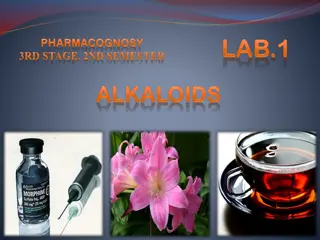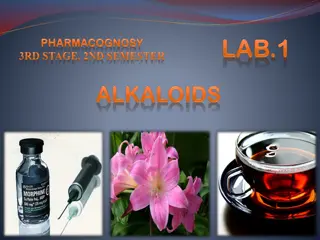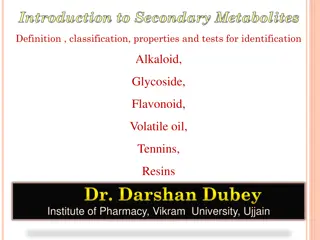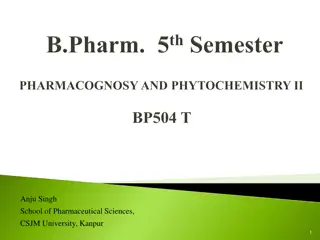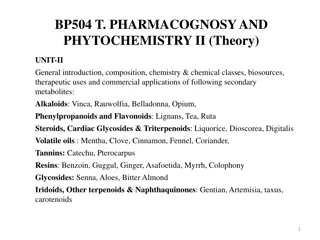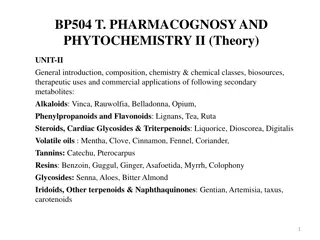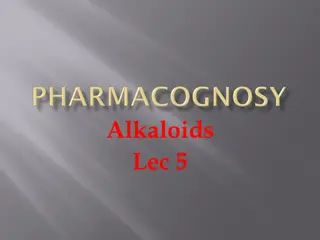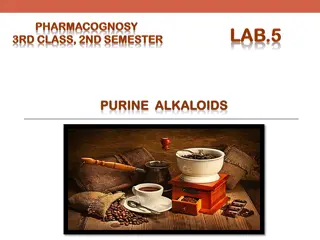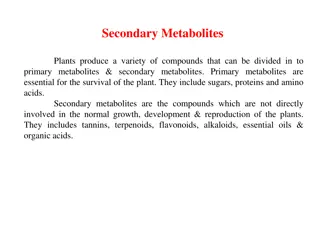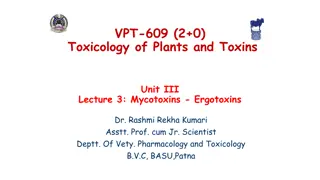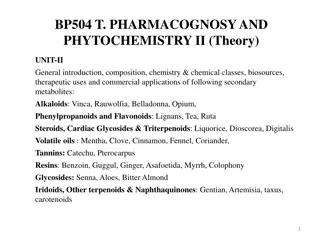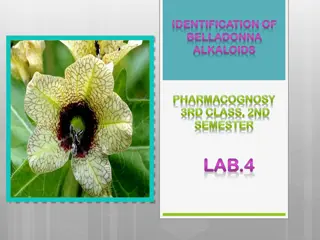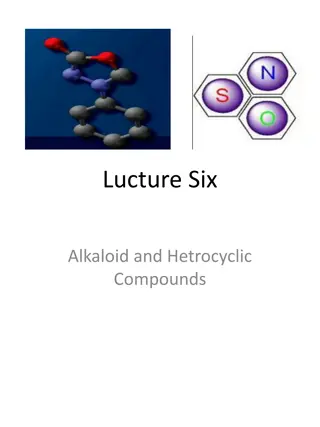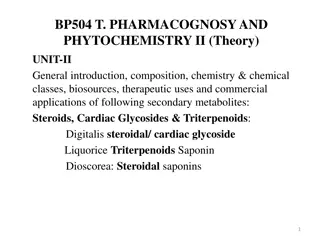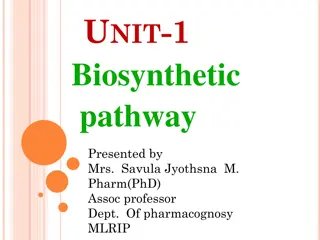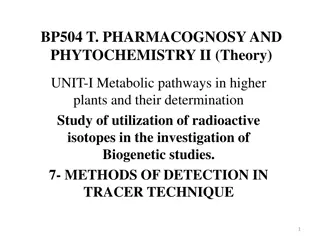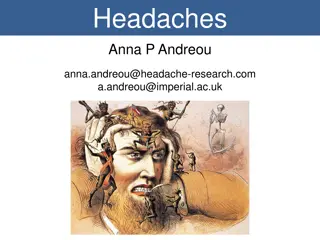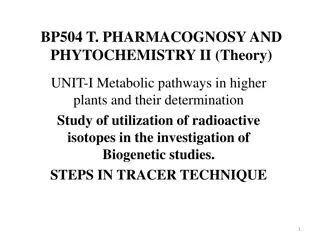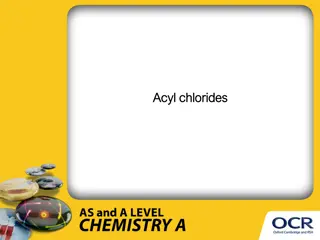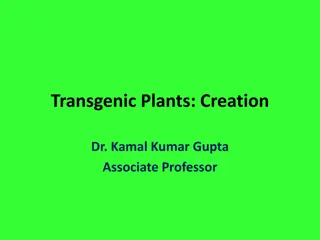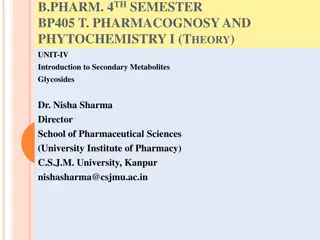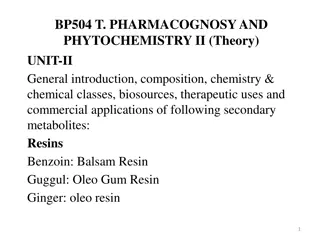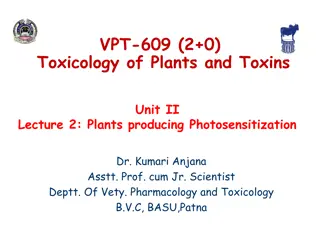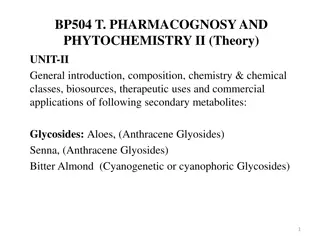Understanding Plants: Primary Vs. Secondary Metabolites and Alkaloids
Plants act as natural bio-chemical factories producing primary and secondary metabolites with distinct roles in growth and adaptation. Primary metabolites are essential molecules like carbohydrates and proteins, while secondary metabolites like alkaloids have marked therapeutic activities. Alkaloids, classified based on origin, are abundant in various plant families and play vital roles in pharmacology. Explore the fascinating world of plant chemistry with a focus on alkaloids.
Download Presentation

Please find below an Image/Link to download the presentation.
The content on the website is provided AS IS for your information and personal use only. It may not be sold, licensed, or shared on other websites without obtaining consent from the author. Download presentation by click this link. If you encounter any issues during the download, it is possible that the publisher has removed the file from their server.
E N D
Presentation Transcript
Plants are the natural bio-chemical factory to generate the various chemicals categorized as Primary and secondary metabolites- PHYTOCONSTITUENTS Primary metabolites Distribution: Wide, simple molecules Involved in reproduction, development & growth Presence in plants: abundant Isolation is in-expensive: starch Mostly don t have therapeutic activity as such, but are precursors for synthesis of secondary metabolites Ex: Carbohydrates, lipids, Proteins, amino acids, nucleic acid Secondary metabolites Distribution: Restricted to plant species or taxonomic, complex molecules Involved in chemical adaptation, environmental stress, as protective chemicals against microbes, animals, insects Expensive to isolate, produce Have marked therapeutic activity Ex. Alkaloids, Glycosides, Flavonoids, Terpenoids, Resins, Tanins etc.
ALKALOIDS German Scientist: Carl F.W. Meissner 1815 , Alkali like : Hence the word Alkaloids Definition: Group of naturally occurring organic compounds, basic in nature, contain 1 or more nitrogen atoms in heterocyclic ring, posses specific physiological action Distribution: Abundant in angiosperm i.e. higher plants Families rich in alkaloids : Apocynaceae (Rauwolfia) Rubiaceae (cinchona), Solanaceae (belladona), Papaveracea (opium), Berberidaceae (podoplyllum) Present in various part of plants like: Aerial parts- Ephedra- ephedrine, Entire plant- Vinca- Vincristine, vinblastine, Leaves- Tea- Caffeine, Root- Rauwolfia- Reserpine, Bark- Cinchona- quinine, Seed: Nuxvomica- struchnine,Fruit- Black pepper- piperine, Latex: Opium- Morphine,codeine etc. Use:Analgesic, Antimalarial, Antispasmodic, hypertension, mental disorders, anticancerous Occurance: as salts of organic acid (oxalic , citric, acetic, maleic, lactic, fumaric, acid etc) Function in plants: Protective: against insects, herbivores (bitterness, toxicity) Some are Product of detoxification (waste products) Reservoir for protein synthesis, Source of N in case of deficiency in plants
Classification based on origin True alkaloid Contain Heterocyclic N atom in ring Obtained from Amino acids directly (Tryptophan, tyrosine, PA, Lysine, ornithine, histidine etc.) Basic in nature, forms water sol. Salts Example: Quinine, Atropine, Morphine Proto alkaloid Amino alkaloid, Contain N but not inside the heterocyclic ring Obtained from Amino acids, biological amine Basic in nature Examples: Colchicine, ephedrine Pseudo Alkaloid Contain Heterocyclic N atom Are not derived from amino acid precusor Weakly basic nitrogenous compounds Examples: Purine alkaloids: caffeine Steroidal alkaloids: Solanidine, conessine Phenyl alanine Caffeine Purine Morphine Tyrosine Tryptophan Quinine
Classification of alkaloids Taxonomical Based on distribution in variuos plants Solanaceae: Tropane- Atropine, hyoscine Steroidal: Solanidine, withanolide Paplionaceae: Pyrolidine, Quinolizidine Grouped as per the genus ex. Ephedra, Cinchona Pharmacological CNS: Caffeine, Strychnine Anticancer: Taxol: Taxus, vincristine, VB Bronchodialator Ephedrine (ephedra) vascisine (vasaka) Narcotic analgesic Morphine: opium Codeine Antihypertensive: Reserpine (rauwolfia) Biosynthetic Based on types of precursor used for biosynthesis of alkaloid in plants Same precursor same group of alkaloids Ex: ornithine: Pyrrolidine: Nicotine, Tropane: Atropine, cocaine Lysine:Pipperidine & pyridine: Coniine, lobeline Quinolizidine: Lysine Tryptophan:Indole: vincristine, reserpine, Quinoline: qunine Histidine: Imidazole: pilocarpine Phenylalanine: Amino alkaloid: ephedrine Tyrosine: Isoquinoline: papaverine
Physical & chemical properties 1. Crystalline solid, some are amorphous solid: emetine Liquid: Nicotine, coniine (volatile) 2. Colorless, some are colored, Berberine, colchicine: yellow, Betanidine: orange 3. Solubility: Free bases soluble in organic solvents (ether, chloroform) Alkaloidal salt sol. In water & alcohol Exceptions: bases soluble in water (caffeine), ephedrine bases insoluble or sparingly soluble in organic solvent- Morphine in ether 4. Isomerisation: optically active isomers show physiological activities, l-ephedrine d ephed 5. Bitter in taste, mainly poisonous 1. Basic in nature, lone pair of electrons in N atom 2. N exists as Primary (RNH2) Nor ephedrine Secondary (R2NH) Ephedrine Tertiary: (R3N) Atropine Quaternary ammonium: Tubocurarine 3. Basicity: R2NH RNH2 R3N Weak base: caffeine (unstable salt) Strong base: Atropine Amphoteric: Morphine Neutral alkaloids: Colchicine 4. Alkaloid + Acid Akaloidal salt 5. Dilute alkali liberate most of alkaloid from its salt
Identification Test of Alkaloids General chemical Test Precipitation Reactions 1. Dragendorff s test: Potassium bismuth Iodide sol: Orange ppt 2. Mayers Test: Potassium mercuric iodide solution: Cream ppt 3. Wagners test: Iodine potassium iodide sol. : Reddish brown ppt 4. Hagers Test: Sat. picric acid sol. Yellow ppt Specific Reagent test: 1. Vitali morin test: Tropane alkaloid+ fuming HNO3 + alc. KOH sol. violet color 2. Van Urk s Test: Ergot alk. (Indole)+ paradimethyl amino benzaldehyde (in dil. H2SO4+ traceof FeCl3) Blue 3. Thalloquin test: Chinchona (quinine)+ Br2 water+ dil. NH3 sol. Emrald green 4. Murexide Test : Caffeine (Purine) + KClO3+ HCl evaporate to dryness dried residue exposed to NH3 vapors purple color


